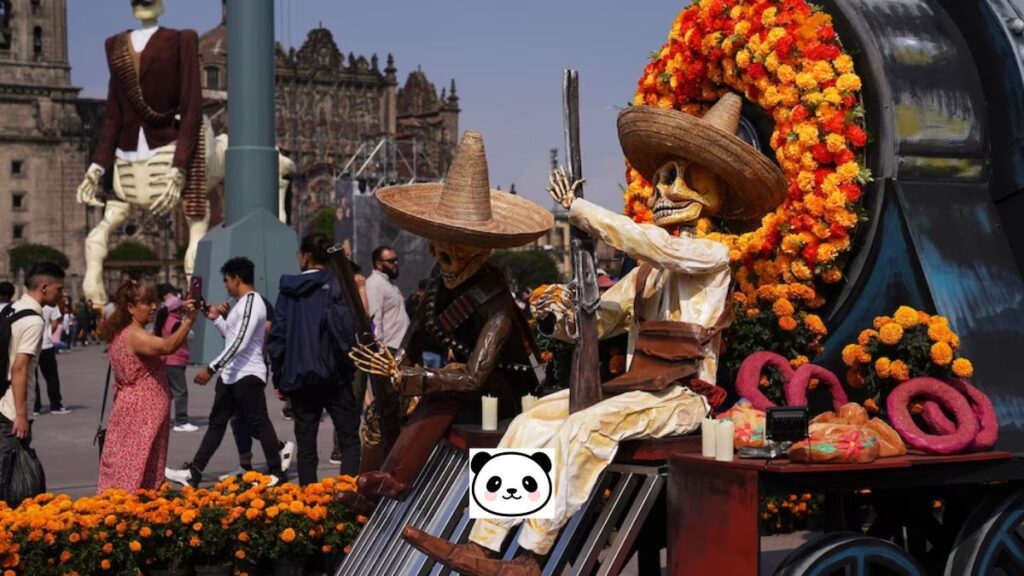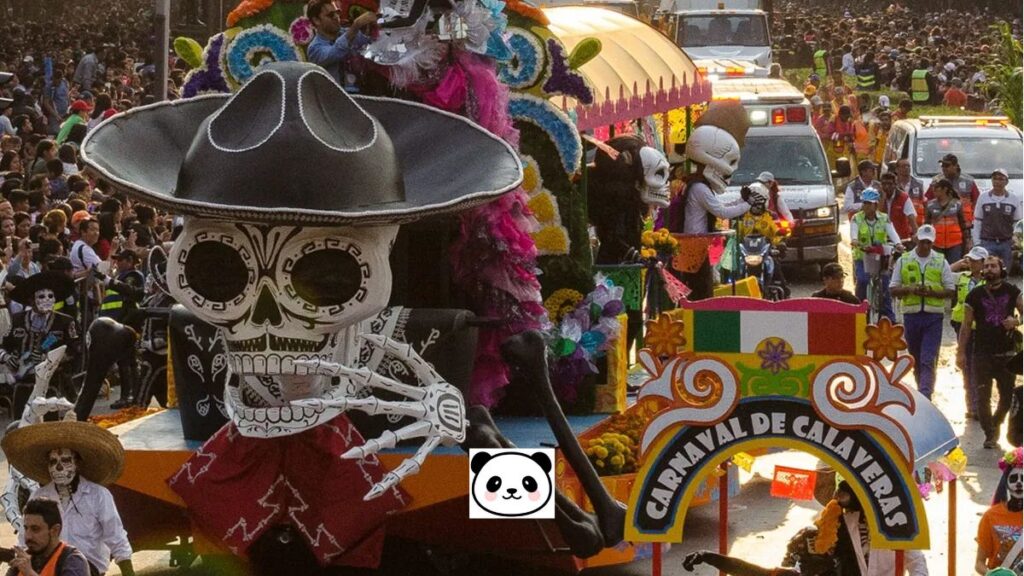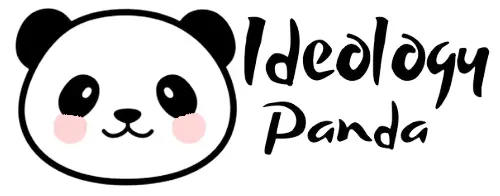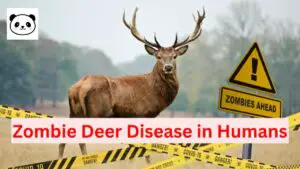Introduction


The Day of the Dead, or “Día de los Muertos” in Spanish, is a vibrant and thought-provoking Mexican event that draws people from all over the world. With a rich history spanning centuries, this lively celebration of life and heritage remains a fundamental aspect of Mexican culture. We will examine the history, meaning, and customs of Day Of The Dead Celebration, including how it came to be, how it is observed now, and its relationship to The Day of the Dead Celebration Festival skull.
The Origins of The Day of The Dead
The Day of the Dead has its origins in pre-Columbian Mesoamerican traditions when native peoples honored the dead with rites. Two such peoples were the Nahua people and the Aztecs. The notion that the deceased were still a part of the community and that, at certain times of the year, their souls would return to the world of the living was the basis for these ceremonies.
Behind the scenes to screen: Day of the Dead celebrations shot in Mexico City. #Spectre pic.twitter.com/8xI6r0a4Vx
— James Bond (@007) October 31, 2023
When Spanish Conquistadors arrived in the early 16th century, they came upon these native customs and tried to replace them with Catholicism. On the other hand, the current Mexican Day of the Dead, observed on November 1st and 2nd, which coincide with All Saints’ Day and All Souls’ Day on the Catholic calendar, originated from the blending of indigenous traditions and Catholicism.
Skull and Its Symbolism
Central to the Day of The Dead Festival is the iconic image of the “Calavera,” or skull. These intricately decorated skulls are a striking visual representation of the holiday and serve as both a symbol and a form of artistic expression. The use of the Day of The Dead skull in various forms is deeply meaningful in the context of this celebration.
La Catrina: La Catrina, a female skeleton dressed in elegant clothing, is perhaps the most recognizable symbol of the Day of The Dead Festival. Created by Mexican illustrator José Guadalupe Posada, La Catrina represents the idea that death is an equalizer, transcending social and economic status.
Sugar Skulls: Sugar skulls, or “calaveras de azúcar,” are an integral part of Day of the Dead celebration. These colorful confections are crafted from sugar and are often inscribed with the names of deceased loved ones. They are both decorative and edible, symbolizing the sweetness of life and remembrance of those who have passed away.
Calacas: “Calacas” are whimsical skeleton figurines used in Day of the Dead displays. These figurines can be found in various forms, from musicians to chefs, and serve to remind people that death is a part of life and that humor can be found even in the face of mortality.
Festival: A Celebration of Life
The Day of The Dead is far from a somber occasion; it is a lively and joyful celebration of life and the memories of those who have departed. Families and communities come together to honor their loved ones and to create elaborate altars, or “ofrendas,” in their homes, cemeteries, and public spaces. These ofrendas are adorned with Day Of The Dead Celebration skull imagery, marigold flowers, candles, incense, and the favorite foods and beverages of the deceased.
Altars: The ofrendas are the focal point of Day of the Dead celebrations. They are meticulously designed to pay tribute to the departed by featuring photographs, mementos, and the favorite belongings of the deceased. The marigold flowers, or “cempasúchil,” are believed to help guide the spirits of the dead back to the world of the living.
Candles and Incense: Candles and incense are lit to illuminate the path for the spirits and to provide an atmosphere of warmth and remembrance. The scent of copal incense is particularly associated with the holiday.
Food and Beverages: Traditional Mexican dishes, such as “pan de muerto” (bread of the dead) and “mole” (a rich sauce), are prepared and offered to the deceased. These offerings are meant to sustain the spirits during their visit.
Music and Dance: Music and dance are integral parts of Day of the Dead celebrations. It is common for families to play the favorite songs and music of their departed loved ones, and communities often come together for lively processions and dances.
Celebration in Mexico
In Mexico, The Day of The Dead is a national holiday, and its traditions are deeply ingrained in the culture. Cities and towns throughout the country come alive with festivities that blend the old and the new, the spiritual and the secular. Some of the most famous Day of the Dead celebrations take place in specific regions:
Dia de los Muertos in Times Square (Day of the Dead) 💀 New York City pic.twitter.com/odpUxGi0Z3
— NewYorkCityKopp (@KellyrKopp) October 27, 2023
Mexico City: The capital city hosts an annual parade known as the “Desfile de Día de Muertos,” featuring colossal puppets, intricately designed floats, and lively performances. The parade has become a major tourist attraction and showcases the fusion of ancient traditions and contemporary culture.
Oaxaca: Oaxaca, known for its rich indigenous traditions, is famous for its vibrant Day of the Dead celebrations. The city is known for its striking sand tapestries, or “Tapetes,” made on the streets and alleys. These intricate and colorful designs honor the deceased and add to the visual splendor of the holiday.
Patzcuaro: The town of Patzcuaro in Michoacán is renowned for its serene and spiritual Day of the Dead celebrations. Families light candles in boats and send them adrift on Lake Pátzcuaro to guide the spirits of their loved ones.
International Recognition and Influence
The Day of The Dead has garnered international recognition and has inspired countless artists, filmmakers, and writers. Its cultural significance and unique symbolism have led to the celebration’s representation in various forms of media and art.


Films: The animated film “Coco,” produced by Disney and Pixar, brought Festival Celebration to a global audience. The film’s vibrant portrayal of Mexican culture and its themes of family and remembrance resonated with viewers worldwide.
Art and Fashion: Day of the Dead Skull and the aesthetics of the holiday have been adopted by fashion designers, artists, and tattoo enthusiasts. The imagery of La Catrina and sugar skulls has become iconic in the realm of pop culture.
Art Installations: Around the world, art installations and exhibitions dedicated to The Day Of The Dead have been featured in museums and galleries. These showcases aim to educate and celebrate the holiday’s significance.
Conclusion
Day Of The Dead Festival, a revered and joyous celebration, is a testament to the enduring connection between life and death. It reminds us to cherish the memories of our departed loved ones and to recognize the beauty of existence. The use of The Day of The Dead skull, marigold flowers, ofrendas, and other symbols serve as poignant reminders of the profound nature of this tradition.
As continues to be celebrated and shared with the world, it underscores the importance of preserving and honoring cultural traditions that celebrate the human experience and the enduring connection between the living and the deceased. It is a testament to the resilience of tradition and the power of remembrance, making it a poignant and visually stunning celebration of life and heritage.
What does the Day of the Dead celebrate?
One of Mexico’s greatest visual extravaganzas, Day of the Dead is a celebration of cultural fusion. Its primary goal is to keep the memory of the deceased alive so that their spirits won’t perish eternally. The most significant place on the altar is occupied by pictures of the departed loved ones.
What is Day of the Dead and why is it celebrated?
However, in Mexico and other Central American nations, one culture has developed a special method of dealing with death and the deceased. During the two days of the Day of the Dead celebration, it is thought that a portal has opened between the physical and spiritual realms, allowing our departed loved ones to pay us a visit.
What was Day of the Dead called?
Día de los Muertos, or Day of the Dead, is a celebration of life and death. While the holiday originated in Mexico, it is celebrated all over Latin America with colorful calaveras (skulls) and calacas (skeletons). Learn how the Day of the Dead started and the traditions that make it unique.
Do you say Happy Day of dead?
In addition, year-round consumption of atole, a corn-based beverage, and spicy dark chocolate are linked with the event. You can say “Feliz día de los Muertos” to someone to wish them a pleasant Day of the Dead.
What is the Day of the Dead in India?
The Indian Day of the Dead
Shraddha rituals are observed by Hindu families across the country, primarily during the Pitru Paksha, which usually spans from the lunar month of Bhadrapada to Ashwina, typically falling from September to October.








